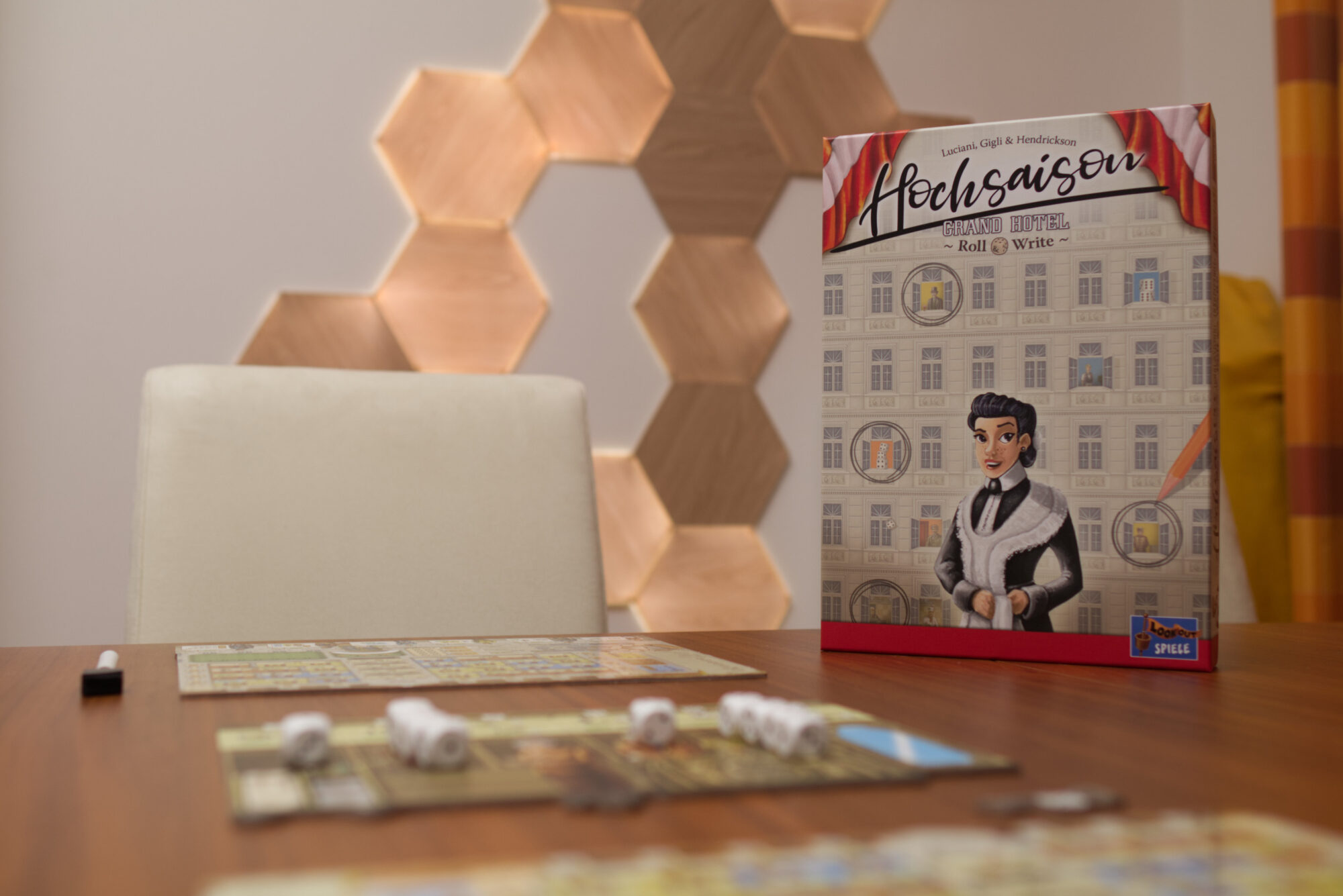Grand Austria Hotel is a game I adore, much more than I rationally should do. It’s punishingly tight, can easily become multiplayer-solitaire, and I get it to the table way too infrequently. But that’s emotions for you, right? There doesn’t have to be a rational explantation why we feel attracted to certain games while we don’t to others. With Grand Austria Hotel, it has a super clever dice-action-selection mechanism, but what won my heart is the lovely theme of serving guests strudel and coffee in order to convince them to stay in your hotel. It’s great! It even got me to visit Vienna in 2023 because I wanted to see what the vibe in the traditional coffee houses is like in reality. It was awesome, the strudel was great, but for some reason nobody tried to upsell me a hotel room.
When a roll-and-write based on Grand Austria Hotel was announced, I had the obvious reaction: on the one hand, I was super excited. On the other hand, the cynicism set in almost immediately. Most roll-and-writes based on a popular title have more of a quick cash grab than they can stand on their own. Plus roll-and-writes in general don’t seem to be my cup of tea. So far, the only one that has stood the test of time for me isn’t Railroad Inc, Ganz Schön Clever, or one of the other popular ones, but On Tour. And even that one doesn’t get to the table that often.
I had the chance to demo a pretty much final pre-production copy at Essen Spiel 2023 which left all players at the table – all Grand Austria Hotel fans – lukewarm. But now that the retail copy is out, I wanted to check it out in depth and see if it would shine on repeated play.
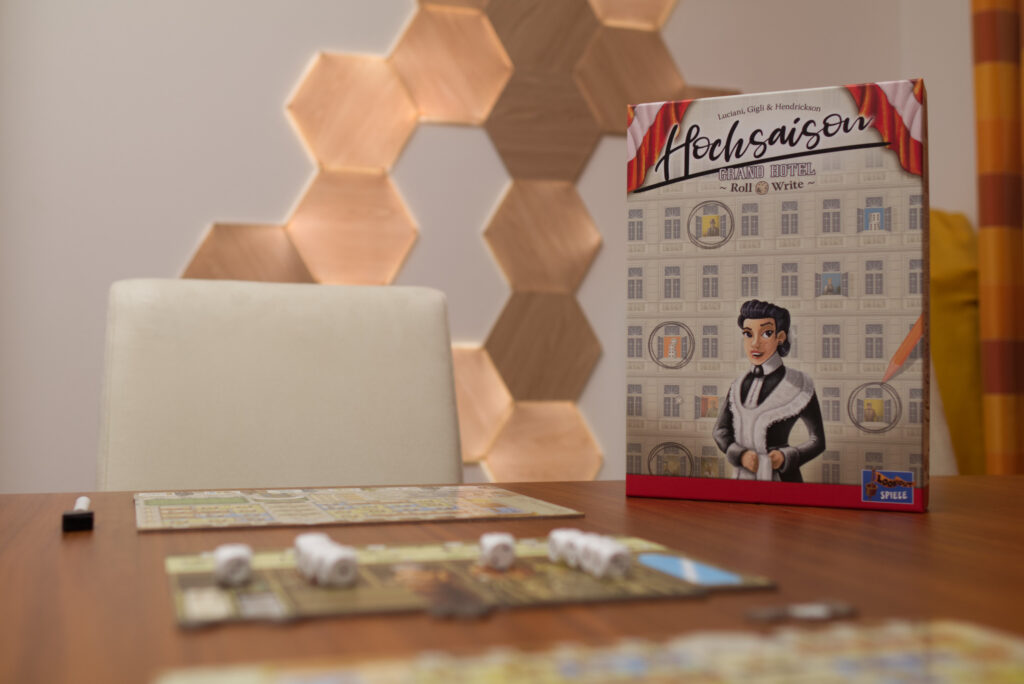
Setup
The nice thing about roll-n-writes is: setup is usually super quick and High Season is no exception to that. The game comes with four laminated, double-sided player boards, four additional also double-sided staff boards, dry erase markers, a couple of good quality wooden dice, a shared main board, and a start player token. That’s it. Pass a random board to each player, place a random staff board at the bottom of the player board and roll the dice. We’re off to the races.
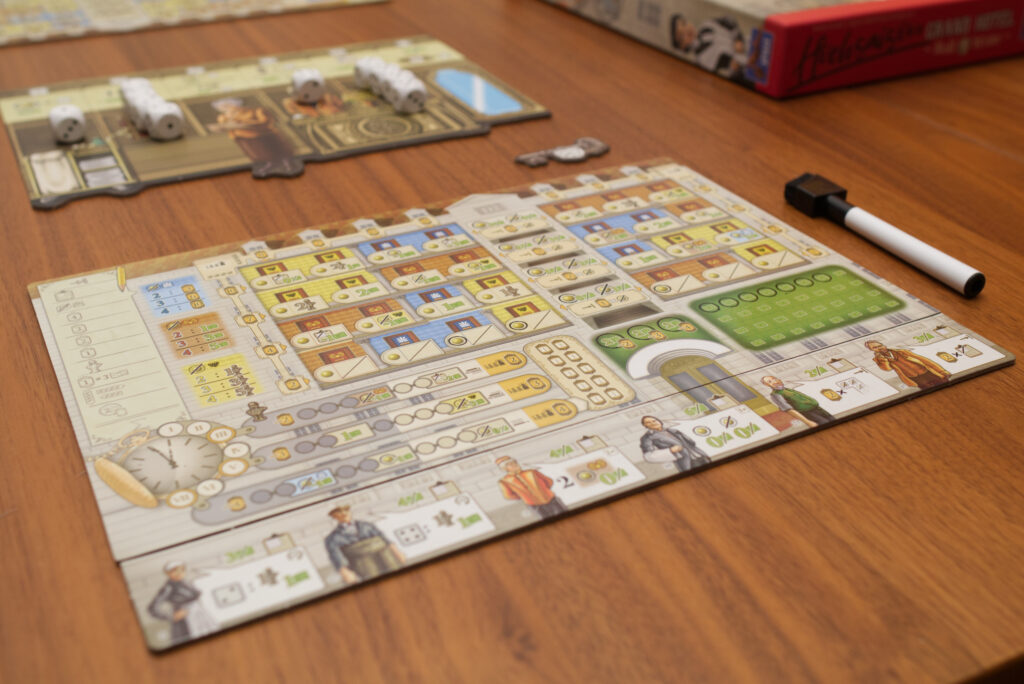
The Turn
Same as the original, High Season is played over just 7 rounds with two actions per player per round. That’s not a lot! At the start of each round, a number of dice (dependent on player count) is rolled and sorted by value (all 1s in the first column, all 2s in the next, and so on). Each column on the main board represents an action that gets stronger the more dice are in that column. Each action by itself is rather simple: 1s prepare rooms for guests equal to the number of dice, 2s mark a single room as occupied with the cost reduced by the number of dice, 3s can be used for either of those two actions, 4s provide money or emperor points (more on them later), 5s allow hiring of a single staff member with the number of dice reducing the costs, and 6s can act as any other action but cost one money to use. As you may have noticed, that means there are only 4 types of actions really as 6s are wild and 3s do the same thing as 1s and 2s. It works mechanically, but produces a strange feeling anyway.
So a player picks a die that’s still available, performs the associated action and crosses of stuff on their board, then removes the die from the main board and this makes the action weaker or even impossible for others if they took the last die of that value. It’s a cool mechanism that worked well in Grand Austria Hotel and works well here, too. However, High Season felt more multiplayer solitaire to me with us rarely really caring which dice another player would need.
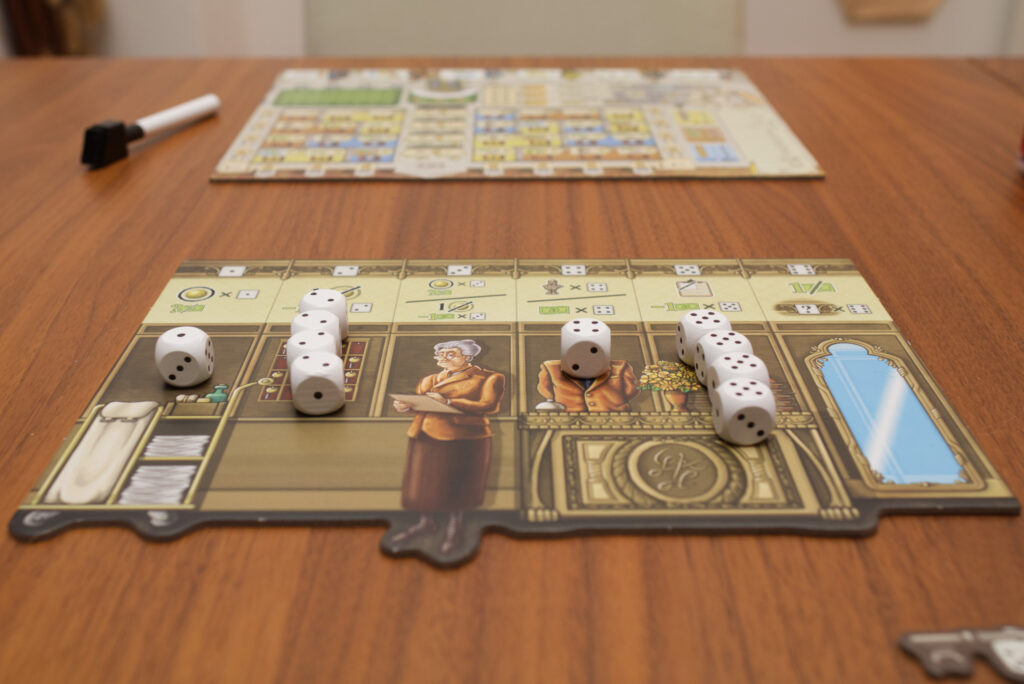
So let’s look at the player boards. Each shows a grid of rooms split by a stairwell. By circling the door nob, a room is marked as prepared, crossing it off marks it as occupied. Similarly a circle around a bank note means it’s available and crossed off it has been spent. To prepare a room, not only a die of that action has to be chosen but also a price has to be paid based on the level the room is on, from 0 to 3 money. Getting a room occupied also costs (1-4) money but also triggers a one time bonus that’s printed on the room, from getting money to hiring staff to preparing a room for free. All of the bonuses are versions of the main actions. When a group of same coloured rooms is completed, another bonus is triggered: red rooms provide money, blue ones VP, and yellow emperor points.
Same as in Grand Austria Hotel, the emperor has decided to pay the hotels a visit at the end of the third, fifth, and seventh round. Each of these is represented by a row of to be crossed off circles. When it’s the for an emperor scoring and a player managed to cross of at least one circle in the grey area of that row, they are safe. If they were the first player to complete all circles, they even get a few VP. If they are still stuck in the dark grey section however, they will get a penalty. The emperor track also features bonus actions when certain milestones are reached, similar to the room bonuses. It’s a simplified version of the emperor track in Grand Austria Hotel where players besides VP also got other bonuses such as hiring a staff member for free or a juice set of resources.
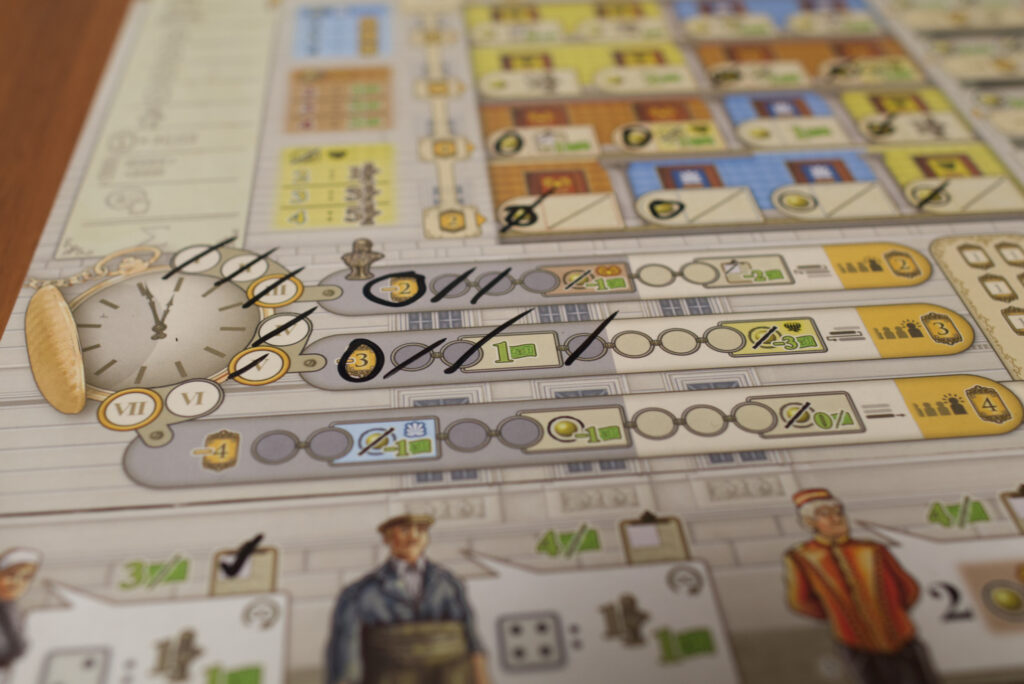
The staff mechanism also has been simplified. In Grand Austria Hotel, players started with a hand of cards and could draw new staff members during the game. They also had to be hired (=activated) by an action, that part is similar, as are the general benefits staff members provide. In High Season though, each player starts with a fixed, unique set of 6 staff members on their board that they can hire. The first two make actions more powerful (e.g. get a money and emperor step whenever choosing a die with a 2 on it), the middle two give one time bonuses (e.g. prepare two red rooms for free), and the final two help score VP at the end of the game (e.g. 2VP for each set of red-blue-yellow rooms).
The jury is still out on how well balanced these are, but in our games, we preferred those that had staff members that provided some form of money income. That might be due to my groups play style or not, it’s difficult to tell.
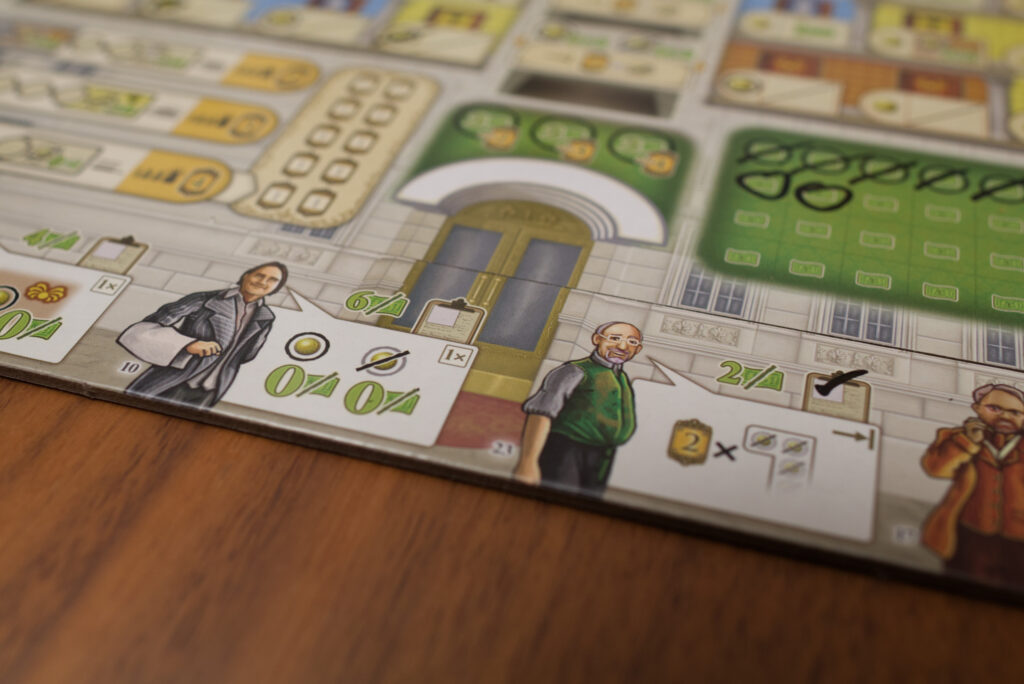
Game End
Each board features a scoring table at the left side of the board. There are various sources of VP, but it’s basically for occupied rooms, staff members, groups of blue rooms, and being the first player to close all rooms in a row or column. Similar to the emperor track, this gives a slight race character to the game. Players might also have accumulated negative points, either by doing poorly on the emperor track or taking a loan of 2 money, something that is represented by three circles on the player board that can be crossed of at any time (for increasingly worse VP costs).
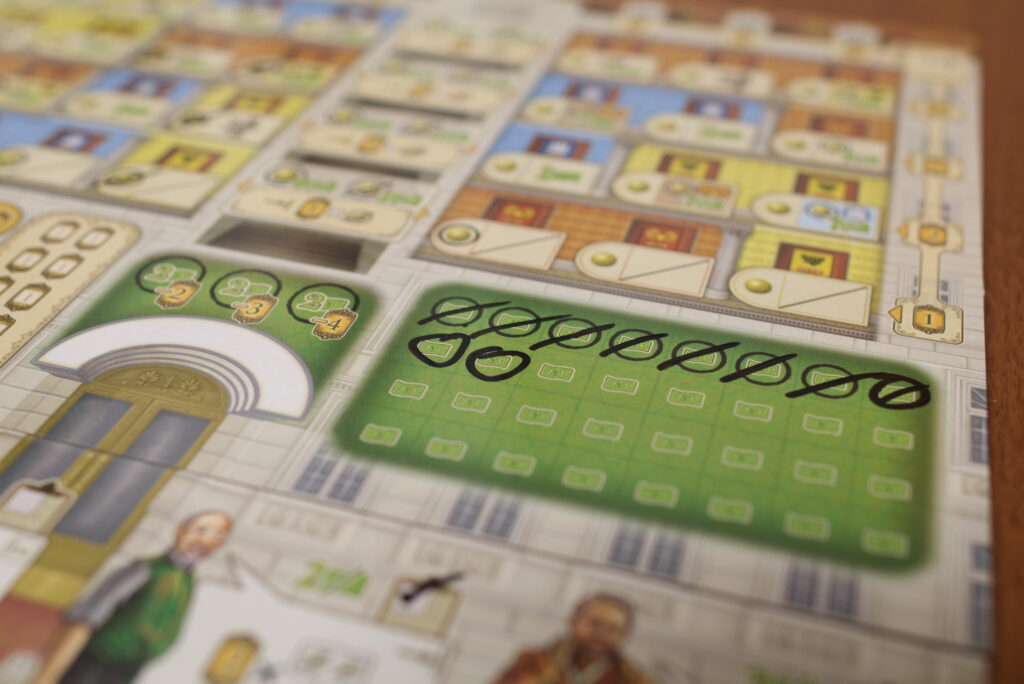
Solo Mode
A bit surprisingly, the game is for 2-4 players and there is no solo mode in the box. However, there is one being developed right now. It’s tricky to talk about in-development things as they inevitably will change. I just briefly wanted to mention it here because I think it’s great it is being worked on at all.
Conclusion
While playing High Season: Grand Hotel Roll & Write, one thing unfortunately became clear quickly: for those that own or know Grand Austria Hotel, there is little reason to play High Season. Sure, it is shorter (20-30min for 2p), but too much of what makes GAH special is lost. Guests have been completely abstracted away and it feels strange to pay money to get a room occupied. There is no food or drinks, no drafting staff, no public goals for achieving certain milestones. To put it in simple term, I believe the designers have chosen the weaker but easier to translate aspect of Grand Austria Hotel and should instead have tried to create a “Grand Austria Café”. Both the resource economy of strudels and wine as well as the fight over the right guests to lure into your hotel would have been a such more evocative, fun theme. The result is a mechanically solid roll-and-write that left most I have played it with wondering why they should play it again.
I intentionally played High Season also with a player that hadn’t been exposed to Grand Austria Hotel and that produced a better reception. After all, the core dice mechanism is quite unique and works well. Having it packed into a game of such short length also makes it a good lunch-break game. However, due to the board layout, the box is quite large (basically imagine the GAH base game with half the thickness) and thus this isn’t really a game to throw in your bag when you’re off to work. Also this game is quite devastating on first play. From the get go, players need to plot out a course of which rooms to score and which bonuses to reach when as otherwise they will run out of money and actions quickly. So having one player that knows the game play while others that don’t is quite problematic.
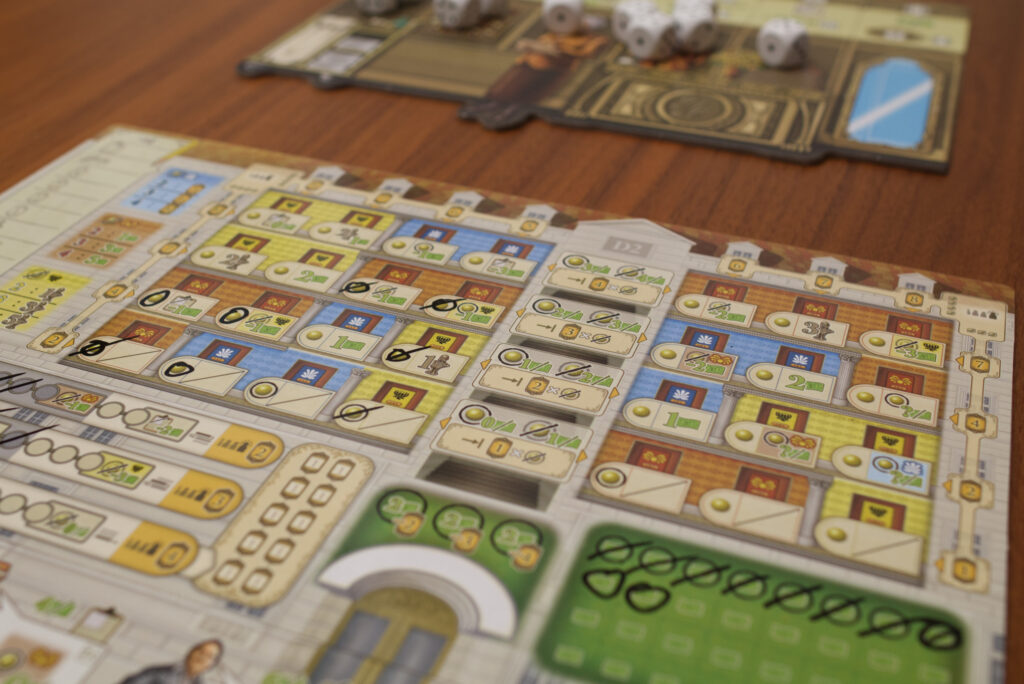
One question I had when I went into this was how much potential there is for improving one’s own skills. Indeed, clever action selection and comboing can increase the scores, but I felt most of the progress was made in my first 2-3 plays. It’s less something you can sink your teeth in and get better and better, it’s more getting an initial feel for the action-economy and then on the second play avoiding some then obvious missteps. What gets most players is that they have this large board filled with hotel rooms but there’s no chance to fill a substantial number of them. Picking the action to occupy a room only allows filling a single room, and one can’t do that all the time because players also need considerable amounts of cash to actually be able to do so. Even when exploiting the maximum of combo bonuses, one is typically stuck with closing 10-14 rooms, which doesn’t really produce a satisfying end result. Grand Austria Hotel is also only 7 turns, but at the end I always had a better sense of achievement.
Overall, there were few moments that felt great. Usually this category of game is designed to give players consistently small boosts of endorphins, almost like a mobile game, but I didn’t have them here. On the contrary, the dependence on the right numbers coming up felt higher than in Grand Austria Hotel because there is no way to pass and re-roll. Imagine investing in a price staff member that enhances the effect you get for using sixes and then hardly any show up for the next three rounds. It just doesn’t feel great if there is no agency to do something against it.
That brings us to the big question: who is this game for? I don’t think it’s for fans of Grand Austria Hotel. So far, none of those that I’ve played High Season with had any interest in returning to it. Due to its box size and punishing economy, it’s also not necessarily for the roll-and-write enthusiast that’s looking for a casual, fun time. It seems to me the sweet spot for High Season is the group of players that like mid-to-heavy games but for some reason haven’t played Grand Austria Hotel or need something like it in under 30min. I’m actually not sure if that audience really exists. If I want a meaty roll/flip-and-write, I would rather go for Hadrian’s wall or Welcome to the Moon. If I need something relaxing and quick, I would go for Railroad Inc or On Tour. That’s a shame, because mechanically speaking High Season is absolutely sound. Maybe if it would have managed to retain more of the charm of Grand Austria Hotel or produced higher player interaction, it would have had better chances to return to my table. The way things are, it is mostly as a reminder that I should bring out Grand Austria Hotel more often again.
